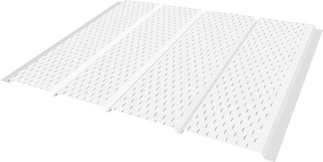Soffit: A Fresh Air Intake for the Attic Space
- Frontline Team

- Mar 30, 2022
- 2 min read
When the soffits of a home are blocked, the attic cannot breathe properly. As a system, the attic space relies on the soffit as air intake and the roof vents as exhaust.
Like a chimney, fresh air flows into the soffits (low point on a roof) and exits out through the roof vents (high point). This ongoing passively vented system is how an attic space is kept cool to prevent snow melt and ice dam build up. Also, a well-ventilated attic won't have condensation problems, dry-rot, and other issues driven by high humidity.
In other words, attic space ventilation is very important and this all starts with the soffit.
Soffit work naturally involves fascia and eavestrough work as well. This is because soffit panels are designed to be installed as the first part of the assembly. Soffit panels are fastened at the fascia, then a fascia capping is made to lap over the soffit (hiding the fasteners). Eavestrough gutters are then mounted to the fascia. The 3 - soffit, fascia, eavestrough - in a way are interconnected.
For example, to do soffit work, eavestrough and fascia must be removed. Or, to do fascia work, eavestrough must be removed.
There are various types of soffit panels...
Soffit panels used for ventilation purposes are perforated, allowing air to enter the attic space while keeping out critters.
The objective when working to improve ventilation is simple: The attic space should be as close to outdoor temperatures as possible - see illustration below...

Most homes in the Sudbury area built in the '70s and earlier have (or have had) blocked soffit. Plywood was, at one time, used to close off the soffit. Further, insulation is often found to be stuffed into the soffit area, restricting the air flow.

During a roof replacement, our team may help with ensuring insulation is clear in this area, but wood soffit can only be removed by removing/replacing the soffit panels. During replacement of soffit panels, a check can also be done to ensure insulation is clear in the area.
It's all about maximizing air flow for efficient dissipation of heat loss and build up of humidity.
Besides the obvious functional benefits of well-executed soffit work, there is an exterior aesthetic component as well. A professional installation of soffit, fascia and eavestrough gives any home a sharp new appearance and dramatically improves the curb appeal.
We love transforming an old and weathered finish to one that brings out the character of the home, while solving the ventilation issues commonly present in pre-1980s homes.
Feel free to request an onsite assessment! Get a quote.
























Comments